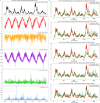Impact of meteorological factors on the incidence of hand, foot and mouth disease in Ningbo from 2014 to 2019: a causal convolutional neural networks
- PMID: 40646519
- PMCID: PMC12247356
- DOI: 10.1186/s12889-025-23634-y
Impact of meteorological factors on the incidence of hand, foot and mouth disease in Ningbo from 2014 to 2019: a causal convolutional neural networks
Abstract
Background: Hand, foot, and mouth disease (HFMD) is recognized as a climate-sensitive disease, yet the precise influence of meteorological factors on its incidence remains underexplored. This study leverages Causal Convolutional Neural Networks (Causal CNNs) to investigate the epidemiological characteristics of HFMD in Ningbo City, China, from 2014 to 2019, and to assess the predictive role of meteorological factors, offering novel insights for real-time surveillance and control.
Methods: Daily meteorological data and HFMD incidence data for Ningbo from 2014 to 2019 were obtained from the Chinese Center for Disease Control and Prevention. The Causal CNNs and the Granger causality test were applied for prediction and analysis.
Results: From 2014 to 2019, the average annual incidence of HFMD in Ningbo was 398.66 per 100,000. The disease showed notable seasonality and annual periodicity, with a bimodal distribution peaking in June-July and October-November each year. The daily mean temperature and relative humidity demonstrated similar annual cyclical variations to HFMD incidence, while daily mean pressure exhibited opposite trends. The Causal CNNs model indicated that daily mean temperature, relative humidity, pressure, and wind speed had better predictive effects with a lag of 19 days [the mean square errors (MSE) were 0.490, 0.333, 0.529, 0.325, respectively, and the mean absolute errors (MAE) were 0.491, 0.355, 0.531, 0.433, respectively]. The Granger causality test confirmed significant correlations between HFMD incidence and daily mean temperature, relative humidity, pressure, and wind speed (The F values were 5.660, 6.878, 4.330, 1.726, respectively, and all P < 0.05).
Conclusion: Meteorological factors, particularly mean temperature, relative humidity, pressure, and wind speed, may significantly influence HFMD incidence in Ningbo. The Causal CNNs model provides relatively accurate predictions, supporting its potential for enhancing HFMD surveillance and informing targeted public health interventions.
Keywords: Causal convolutional neural networks; Granger causality test; Hand, foot and mouth disease; Meteorological factors.
© 2025. The Author(s).
Conflict of interest statement
Declarations. Ethics approval and consent to participate: Not applicable. Since no primary data collection was undertaken and no patients or public were involved, no formal ethical assessment or informed consent was required. All data were collected from National Population Health Data Center (PHDA) ( http://www.ncmi.cn ) and were fully anonymized. Consent for publication: Not applicable. Competing interests: The authors declare no competing interests.
Figures



Similar articles
-
Influence of the Enterovirus 71 Vaccine and the COVID-19 Pandemic on Hand, Foot, and Mouth Disease in China Based on Counterfactual Models: Observational Study.JMIR Public Health Surveill. 2024 Dec 17;10:e63146. doi: 10.2196/63146. JMIR Public Health Surveill. 2024. PMID: 39692430 Free PMC article.
-
Exploring the spatiotemporal effects of meteorological factors on hand, foot and mouth disease: a multiscale geographically and temporally weighted regression study.BMC Public Health. 2024 Nov 12;24(1):3129. doi: 10.1186/s12889-024-20596-5. BMC Public Health. 2024. PMID: 39533262 Free PMC article.
-
Epidemiological trends of hand, foot, and mouth disease in children under age 10, Jiangning District, Jiangsu, China (2009-2023).BMC Infect Dis. 2025 Jul 2;25(1):886. doi: 10.1186/s12879-025-11281-y. BMC Infect Dis. 2025. PMID: 40604541 Free PMC article.
-
Ambient temperature, humidity and hand, foot, and mouth disease: A systematic review and meta-analysis.Sci Total Environ. 2018 Jun 1;625:828-836. doi: 10.1016/j.scitotenv.2018.01.006. Epub 2018 Jan 12. Sci Total Environ. 2018. PMID: 29306826
-
Sertindole for schizophrenia.Cochrane Database Syst Rev. 2005 Jul 20;2005(3):CD001715. doi: 10.1002/14651858.CD001715.pub2. Cochrane Database Syst Rev. 2005. PMID: 16034864 Free PMC article.
References
-
- Cox B, Levent F, Hand, Foot, Disease M. JAMA. 2018;320(23):2492. 10.1001/jama.2018.17288. - PubMed
-
- Nassef C, Ziemer C, Morrell DS. Hand-foot-and-mouth disease: a new look at a classic viral rash. Curr Opin Pediatr. 2015;27(4):486–91. 10.1097/MOP.0000000000000246. - PubMed
-
- Li K, Chen S, Li Z, Shen Y, Zhang Y, Wang F, et al. Epidemiological characterization of hand, foot, and mouth disease among hospitalized children from 2014 to 2023 in a hospital in Henan province: longitudinal surveillance study. J Med Virol. 2024;96(9):e29916. 10.1002/jmv.29916. - PubMed
MeSH terms
Grants and funding
LinkOut - more resources
Full Text Sources

